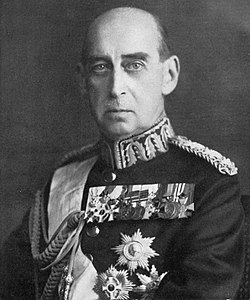Mikuláš Řecký a Dánský
| Mikuláš Řecký a Dánský | |
|---|---|
 princ Mikuláš, 1905 | |
| Narození | 22. ledna 1872 Athény, Řecké království |
| Úmrtí | 8. února 1938 Athény, Řecké království |
| Pohřben | Královský hřbitov, Tatoi, Řecko |
| Manželka | Jelena Vladimirovna Ruská |
| Potomci | Olga Řecká a Dánská Alžběta Řecká a Dánská Marina Řecká a Dánská |
| Dynastie | Glücksburkové |
| Otec | Jiří I. Řecký |
| Matka | Olga Konstantinovna Romanovová |
| Příbuzní | Konstantin I. Řecký, Jiří Řecký, Alexandra Řecká a Dánská, Marie Řecká a Dánská, Olga Řecko-Dánská, Ondřej Řecký a Dánský a Kryštof Řecký a Dánský (sourozenci) Alžběta Srbská[1], Alexandr Srbský a Nikola Jugoslávský[1] (vnoučata) |
| Některá data mohou pocházet z datové položky. | |
Mikuláš Řecký a Dánský (22. ledna 1872, Athény – 8. února 1938, Athény) z glücksburské větve rodu Oldenburků, byl čtvrtým dítětem a třetím synem krále Jiřího I. Řeckého a královny Olgy. V rodině mu říkali "řecký Nicky", aby ho odlišili od jeho ruského bratrance cara Mikuláše II. Princ Mikuláš byl nadaný malíř, své práce často podepisoval jako "Nicolas Leprince".
Manželství a potomci
29. srpna 1902 se třicetiletý princ Mikuláš v Carském Selu oženil s o deset let mladší ruskou velkokněžnou Jelenou Vladimirovnou, dcerou velkoknížete Vladimíra Alexandroviče a Marie Meklenbursko-Zvěřínské, jedinou sestrou budoucího pretendenta ruského trůnu Kirilla Vladimiroviče.
Manželé spolu měli tři dcery:
- Olga Řecká a Dánská (11. června 1903 – 16. října 1997) ⚭ 1923 Pavel Karađorđević (27. dubna 1893 – 14. září 1976), jugoslávský princ–regent
- Alžběta Řecká a Dánská (24. května 1904 – 11. ledna 1955) ⚭ 1934 hrabě Karel Teodor z Törring-Jettenbachu (22. září 1900 – 14. května 1967)
- Marina Řecká a Dánská (13. prosince 1906 – 27. srpna 1968) ⚭ 1934 Jiří, vévoda z Kentu (20. prosince 1902 – 25. srpna 1942)
Princezny vychovávala anglická chůva Kate Foxová, známá jako "Nurnie".
Veřejný život
Spolu se svými staršími bratry Konstantinem a Jiřím Mikuláš pomáhal v Athénách organizovat Letní olympijské hry 1896; byly to první olympijské hry pořádané od roku 393. Mikuláš byl presidentem Podvýboru pro střelbu.
Jeho otec mu odkázal Královské řecké divadlo, které Mikuláš v roce 1935 přenechal řeckému státu. Přátelil se s Jiřím Simitem a byl kmotrem jeho syna, budoucího socialistického předsedy vlády, Kosty Simita.
Princ Mikuláš zemřel 8. února 1938 ve věku 66 let v Athénách a byl pohřben v královské hrobce paláce Tatoi.
Tituly, oslovení a vyznamenání
Tituly a oslovení
- 22. ledna 1872 – 8. února 1938: Jeho královská Výsost princ Mikuláš Řecký a Dánský.
Vyznamenání
- Řád slona
- Čestný kříž řádu Dannebrog
- Pamětní medaile zlaté svatby krále Kristiána IX. Dánského a královny Luisy
- Medaile stého výročí Kristiána IX.
- Velkokříž řádu Karla III.
- Čestný kříž královského Viktoriina řádu
- Řád zvěstování
Vývod z předků
Reference
V tomto článku byl použit překlad textu z článku Prince Nicholas of Greece and Denmark na anglické Wikipedii.
Externí odkazy
 Obrázky, zvuky či videa k tématu Mikuláš Řecký a Dánský na Wikimedia Commons
Obrázky, zvuky či videa k tématu Mikuláš Řecký a Dánský na Wikimedia Commons
Média použitá na této stránce
Autor: Di (they-them), Licence: CC BY-SA 4.0
Royal arms of Denmark from 2024, based on information from https://www.kongehuset.dk/en/the-monarchy-in-denmark/the-royal-symbols/the-royal-coat-of-arms/# (image).
Coat of arms of the Kingdom of Greece in 1936–1973
- Royal Coat of Arms of Greece under the Glücksburg dynasty, created after the restoration of King George II to the throne in 1935, to the exile of King Constantine II in 1967 and finally until the abolition of the monarchy in 1973.
- The Escutcheon features the white cross on a dark blue field of Greece. The Inescutcheon features the Arms of the Greek line of the House of Schleswig-Holstein-Sonderburg-Glücksburg. The shield is then topped with a golden Royal Crown.
- It features an escutcheon divided by the red and white cross of the Order of the Danneborg, the first quarter features the arms of Denmark (three crowned blue lions and nine hearts in yellow field). The second of Schleswig (two blue lions passant in yellow field). The third divided into four; the chief features the three royal crowns in blue field of the Kalmar Union, the second half with a crowned stockfish on red field of Iceland and the last half divided between the ram of the Faroe Islands and a polar bear of Greenland, both on blue fields. The fourth quarter is divided between two halves, the chief depicts a yellow field with a blue lion passant over nine red hearts of the King of the Goths, the lower half depicts a crowned golden lindorm on a red field of the King of the Wends.
- Upon it is another inescutcheon in red, divided into four quarters: the first a a silver nettle leaf of Holstein, the second the a swan with a golden crown of Stormarn, the third a knight dressed in golden armor on a silver horse of Dithmarschen and the fourth of a golden horse's head of Lauenburg.
- Upon it is another inescutcheon divided the first features the red and yellow bars of Oldenburg, the second a golden cross on a blue field of Delmenhorst.
- The escutcheon rests on a golden pedestal and supported by two human figures representing the Greek mythological hero Herakles (Heracles), holding a wooden club and wearing the skin of the Nemean lion.
- The escutcheon is surrounded by the ribbon and cross of the Order of the Redeemer, the cross depicts Christ Pantocrator, surrounded by the order's motto:"Η ΔΕΞΙΑ ΣΟΥ ΧΕΙΡ, ΚΥΡΙΕ, ΔΕΔΟΞΑΣΤΑΙ ΕΝ ΙΣΧΥΙ" or "Thy right hand, O Lord, is become glorious in power" from Exodus, 15:6.
- The motto of the Coat of arms and of the dynasty, depicted on a golden ribbon below the pedestal reads: "Ἰσχύς μου ἡ ἀγάπη τοῦ λαοῦ" or "The people's love, my strength"
- The coat of arms is then surrounded by a dark blue mantle and topped with another royal crown.


